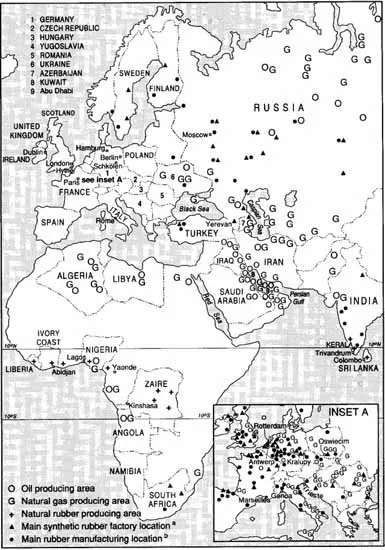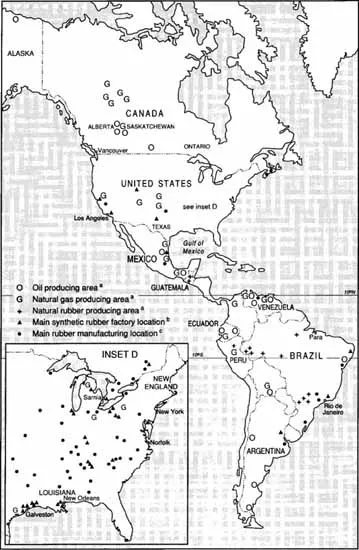
This is a test
- 364 pages
- English
- ePUB (mobile friendly)
- Available on iOS & Android
eBook - ePub
The World Rubber Industry
Book details
Book preview
Table of contents
Citations
About This Book
Despite the fact that Rubber is one of the world's major commodities, surprispingly little has been written about hte the subject. First published in 1994, The World Rubber Industry seeks to redress this deficiency. It presents information in a clear and accessible manner, with numerous tables and illustrations, and an extensive glossary. This is a comprehensive and definitive analysis of one of the world's major and most essential commodities.
Frequently asked questions
At the moment all of our mobile-responsive ePub books are available to download via the app. Most of our PDFs are also available to download and we're working on making the final remaining ones downloadable now. Learn more here.
Both plans give you full access to the library and all of Perlego’s features. The only differences are the price and subscription period: With the annual plan you’ll save around 30% compared to 12 months on the monthly plan.
We are an online textbook subscription service, where you can get access to an entire online library for less than the price of a single book per month. With over 1 million books across 1000+ topics, we’ve got you covered! Learn more here.
Look out for the read-aloud symbol on your next book to see if you can listen to it. The read-aloud tool reads text aloud for you, highlighting the text as it is being read. You can pause it, speed it up and slow it down. Learn more here.
Yes, you can access The World Rubber Industry by Colin Barlow,Sisira Jayasuriya,C Suan Tan in PDF and/or ePUB format, as well as other popular books in Business & Business General. We have over one million books available in our catalogue for you to explore.
1
INTRODUCTION
Rubber is a key material in modern life. Its main application is in vehicle tyres, but it is also used in a vast array of other articles ranging from conveyor belts to examination gloves (Table 1.1). On average each global inhabitant in 1990 consumed 2.9 kg of rubber, although individual countries varied widely in this figure (Table 1.2). The total value of all rubber produced and consumed in 1992, which was a year of low prices, was some $20 billion. Thus rubber is one of the world's major industrial raw materials.
Rubber comes from two very different sources, one ‘natural’ and one ‘synthetic’. Making natural rubber (abbreviated as NR) entails cultivating what was originally a tree of the Amazonian jungle, Hevea Brasiliensis. This has its bark ‘tapped’ through a long cut around its trunk. The white rubber liquid or ‘latex’ flowing from that cut is collected in a small cup, and processed into raw intermediate rubber for industrial use. Making synthetic rubber (SR) entails using an industrial process to convert monomers obtained from oil or natural gas into latex. This is again transformed into intermediate rubber.
While most Hevea trees are grown on tiny plots by smallholders in poorer countries, synthetic rubber is made in great factories which may themselves
| Cellular and foam articles | Inflatables |
| (mattresses and padding) | Electrical insulation |
| Carpet underlays | Tyres and tubes |
| Adhesives | Fenders |
| Hot water bottles | Auto-components (wipers, bumpers) |
| Gumboots | Mats |
| Sheeting | Seals and gaskets |
| Conveyor belts | Condoms |
| Medical and industrial gloves | Rubber bands |
| Diving suits | Balloons |
| Hoses | Roofing materials |
| Shoes | Bridge bearings |
| Walksurfaces |
| Western Europe | 7.4 (3182.9)b | Latin America | 2.0 (835.0) |
| West Germany | 11.6 (720.2) | Brazil | 2.7 (402.0) |
| France | 9.4 (529.2) | Mexico | 2.1 (174.0) |
| Italy | 7.6 (439.5) | ||
| United Kingdom | 6.8 (387.0) | Middle Eastc | 0.3 (60.9) |
| Egypt | 0.4 (21.0) | ||
| Eastern Europe | 7.7(3016.5) | ||
| Former USSR | 8.7(2495.0) | ||
| Former Czechoslovakia | 11.2 (174.0) | Africa | 0.5 (241.0) |
| Poland | 4.3 (162.0) | Nigeriac | 0.2 (22.0) |
| Romania | 5.2 (120.0) | South Africa | 3.2 (112.0) |
| North America | 10.5(2892.3) | World | 2.9 (15111.0) |
| United States | 10.6(2628.3) | ||
| Canada | 10.1 (264.0) | ||
| Asia-Oceania | 1.8(4955.4) | ||
| Japan | 14.7(1810.0) | ||
| China | 0.9 (947.0) | ||
| Korea | 11.7 (498.0) | ||
| India | 0.5 (447.9) |
Sources: Rubber data: International Rubber Study Group (1946–93) and Industry Estimates (1963–93); population data: World Bank (1992).
Notes: a. Both synthetic and natural.
b. Figures in parentheses are total annual consumption (′000 t).
c. Figures estimated on basis of available information (Industry Estimates, 1963–93).
be only small components of huge petrochemical installations. Indeed, some SR factories are so large that they produce as much rubber as whole countries engaged in NR production. Hence the giant Goodyear Tire and Rubber Company styrene-butadiene SR plant at Houston, Texas, which has a staff of some 500 workers, produces about the same quantity of rubber as the 180,000 farmers engaged with NR in the whole of southern India. Again, while all NR must be grown in tropical high rainfall regions within 10 degrees of the equator, and hence far from most ultimate consumers, SR is largely made in industrial areas of Western and Eastern Europe, North America, and north-east Asia. It is, accordingly, close to the manufacturing plants that utilize it, and to the people that consume it as rubber goods. The chief world locations of NR and SR production, of oil and natural gas fields, and of major rubber goods manufacturing, are shown in Figure 1.1.
KINDS OF RUBBER
The term ‘rubber’ is used to describe ‘a group of materials which are highly elastic: a strip of rubber can be stretched several-fold without breaking, and
Figure 1.1 World locations of oil and natural gas production, and of rubber production and manufacturing, early 1990s

Sources: Oil and natural gas locations: Australian Surveying and Land Information Group (1988); Blake, Dewdney and Mitchell (1987); United States, Central Intelligence Agency (1990); Cuff and Young (1980); Dewdney (1982); Evans (1986); Milner-Gullard and Dejevsky (1989); and Oxford University Press (1972). Synthetic rubber factory locations: International Institute of Synthetic Rubber Producers (1981–92). Natural rubber production locations: Barlow (1978) and Chapman (1991). Rubber manufacturing locations: European Rubber Journal (1991).

Notes: a. All substantial oil, natural gas, and natural rubber producing areas are included. Unfortunately, precise data on area capacities were not secured.
b. Commodity and medium tonnage synthetic rubber factories or complexes with annual capacities of at least 30,000 tonnes. Smaller capacity plants are excluded.
c. Rubber manufacturing plants or complexes with annual capacities of at least 2 million tyres or 30,000 tonnes of production. Smaller capacity plants are excluded.

will return quickly to its original length on releasing the stretching force’ (Jones and Allen, 1990: 1). Yet the raw rubber from an SR factory or NR smallholding is plastic and malleable, and does not yet have this all-important and distinguishing feature of elasticity. To secure this and other desirable properties it must go through the chemical process of ‘vulcanization’, which is undertaken when rubbers are manufactured into final goods.
There are many different rubbers, and SR in par...
Table of contents
- Cover
- Half Title
- Title Page
- Copyright Page
- Original Title Page
- Original Copyright Page
- Table of Contents
- List of figures
- List of tables
- Preface
- 1 Introduction
- 2 The History of Natural Rubber
- 3 The History of Synthetic Rubber
- 4 The Production of Synthetic Rubber
- 5 Other Aspects of Synthetic Rubber
- 6 The Production of Natural Rubber
- 7 Other Aspects of Natural Rubber
- 8 The Development of Rubber Goods Industries
- 9 Rubber Consumption
- 10 International Marketing and Trading of Elastomers
- 11 Price Formation and Market Regulation
- 12 Conclusions and Appraisals
- Appendix
- Glossary
- Notes
- Bibliography
- Author index
- Subject index